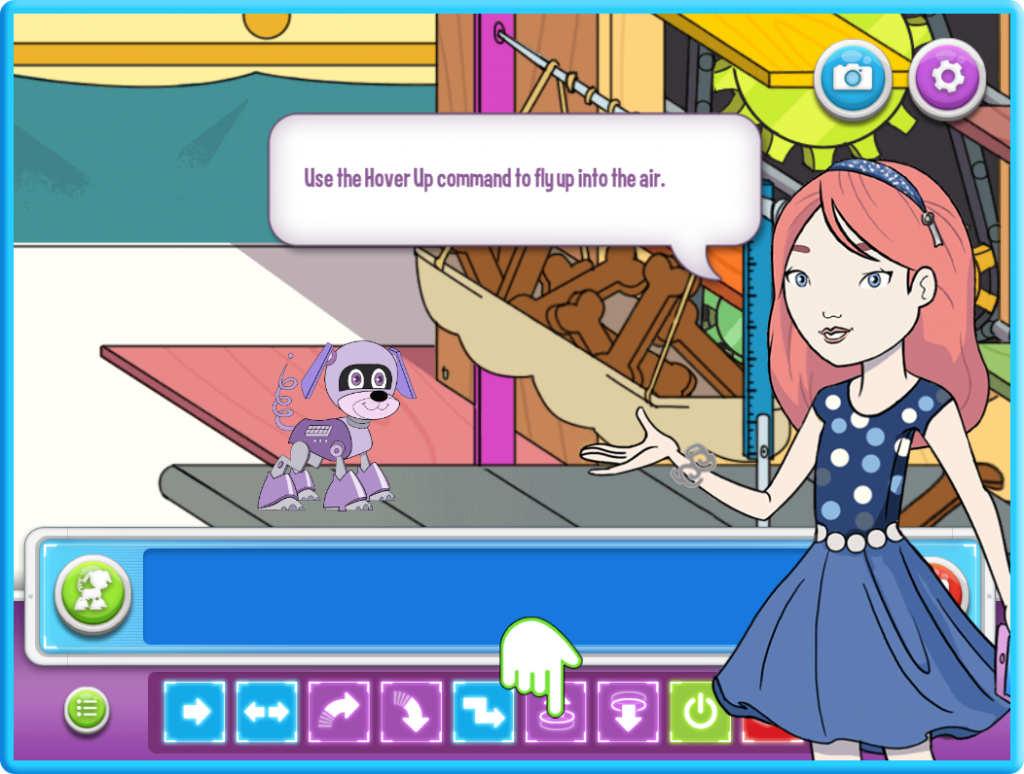 Since releasing their first Nancy Drew adventure game, Secrets Can Kill, back in 1998, Her Interactive has inspired thousands to pick up a virtual magnifying glass and take on the role of amateur detective—including 2015 STEM Challenge winner Olivia Thomas. Based out of Bellevue, Washington, the Her Interactive team has produced over 30 first-person mystery games in the last 18 years. This month, they launched Nancy Drew: Codes & Clues, aimed at introducing early learners to coding and STEM skills.
Since releasing their first Nancy Drew adventure game, Secrets Can Kill, back in 1998, Her Interactive has inspired thousands to pick up a virtual magnifying glass and take on the role of amateur detective—including 2015 STEM Challenge winner Olivia Thomas. Based out of Bellevue, Washington, the Her Interactive team has produced over 30 first-person mystery games in the last 18 years. This month, they launched Nancy Drew: Codes & Clues, aimed at introducing early learners to coding and STEM skills.
To get the inside scoop on all things Nancy Drew, we did what any good sleuth would do—we went straight to the source. Read on for insights on game design and story development from twin sisters Cathy Roiter, lead game designer, and Jeanne Roiter, lead tester at Her Interactive.

When did you become interested in developing and testing video games?
Cathy: I discovered design in a roundabout way through computer graphics. Interested in becoming an animator but wanting a broader education, I received my B.A. in art from a liberal arts college. The liberal arts background is actually an ideal match for design, as I need to pull from various subjects (such as language, math, science, theater or art) for any given game. Though animation was what lead me to games, I received the opportunity to assist in design and quickly realized design was a great match for me.
Jeanne: I am lucky enough to have parents who encouraged learning and grew up surrounded by STEAM. My earliest game experience, King’s Quest IV: The Perils of Rosella, cemented a lifelong gaming love of logic, puzzles, and looking for loopholes. Turns out this drive to find alternative solutions is a perfect fit for game development.
How do you translate a Nancy Drew story into an engaging experience for players?
Cathy: One of the great things about Nancy is that she’s a curious person. Her detective work provides logical opportunities to integrate learning into games in a fun and unassuming way. Players make these discoveries with Nancy as they investigate, whether that’s deciphering hieroglyphics in Tomb of the Lost Queen or learning the basics of coding in Codes & Clues.
For story based mystery adventure games such as ours, we begin with the five Ws of investigation: who, what, where, when, and why. Once we have this mystery synopsis set, we flush out characters and story points to a full narrative outline. Then the visual style is chosen, and we start designing puzzles and activities based around story points.
As the team begins creating the art and code for the game, we dive into an iterative design process with weekly build reviews and walkthroughs to provide feedback on the current state of the game. Changes are made as needed, with the designer responsible for ensuring design integrity. This collaborative iterative process continues through to the end of the project.
Jeanne: There also needs to be a certain level of authenticity to the game content. While presented within a fictitious game setting, players still need to be able to trust that the learning material they encounter through art, dialog, or written assets is legitimate. Careful attention to detail within our games enables players to trust in the accuracy of our educational content.

What’s the toughest part of the development process? How do you work through it?
Cathy: The most challenging part of the process is putting all of the pieces together. It takes incredible organizational skills, fine attention to detail, a logical mind and creative problem solving to blend it into a cohesive whole.
I’ve found the best tool is to create a visual logic map of the entire game, displaying how elements connect and all the possible paths through the game. Having this reference to quickly see how a change at the end may cause a cascading effect back to the beginning is invaluable in keeping the design stable and the story on track.
Jeanne: In quality assurance, you focus on quality, but you’re also an advocate for the end user. It can be a challenge to anticipate their reactions and needs in game play. Sometimes the things we consider imperative to fix really don’t impact the player’s experience at all, and vice versa. Getting user feedback throughout the development process is critical for a successful end product.
What advice do you have for young people interested in designing and developing video games of their own?
Cathy: Go out and try as many things as you can. Take classes in different subjects, go to an event you wouldn’t normally attend, travel as much as you can, talk to new people—the more you learn and experience, the more you have to draw from when designing your own games.
Another great exercise is to look at the world around you with a critical and creative eye. Take an object and then come up with a variety of ways to solve the problem it presents. For example, to open a locked wooden door: use a key, lock pick, take an axe to it, pop the hinges, program robot puppy to crawl under the door, get a beaver to chew a hole through the door – the solutions are as endless as your imagination. This sort of creative problem solving is essential in creating games.

Jeanne: Remember to work as a team. The creative collaboration of game development is such a rewarding aspect of the industry. So make sure you learn how to work with a wide variety of people and inputs. There will always be some give and take, be okay with that, and you’ll be amazed at what your team can accomplish.
Any additional tips for aspiring game designers ?
Cathy and Jeanne: Game design is a wonderfully rewarding career, but there are a few things that will help you become a better designer:
-
The key to any great design is in the details; start broad and then dive in to fully develop every aspect.
-
Be able to take criticism and be willing to make changes, but also stand up for the integrity of your design.
-
Communication skills are essential for a designer—you can’t expect your team to read your mind. You’ll need to be able to communicate detailed designs clearly in writing and in person.
-
The first project will always take longer than you expect. Plan accordingly.
-
One of the most valuable resources you can have are fellow industry professionals. There are local and national gaming groups for all branches of game development that individuals can join. Search your area for a group that aligns with your interests and sign up.
- What you begin with is never what you end up with. Embrace the iterative process and be open to change to create the best game possible!
What stories inspire you to explore new skills or subjects? Share your favorites in the comments.




